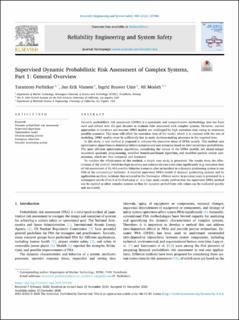| dc.contributor.author | Parhizkar, Tarannom | |
| dc.contributor.author | Vinnem, Jan Erik | |
| dc.contributor.author | Utne, Ingrid Bouwer | |
| dc.contributor.author | Mosleh, Ali | |
| dc.date.accessioned | 2022-09-08T12:25:34Z | |
| dc.date.available | 2022-09-08T12:25:34Z | |
| dc.date.created | 2021-05-12T13:32:04Z | |
| dc.date.issued | 2021 | |
| dc.identifier.citation | Reliability Engineering & System Safety. 2021, 208 1-12. | en_US |
| dc.identifier.issn | 0951-8320 | |
| dc.identifier.uri | https://hdl.handle.net/11250/3016628 | |
| dc.description.abstract | Dynamic probabilistic risk assessment (DPRA) is a systematic and comprehensive methodology that has been used and refined over the past decades to evaluate risks associated with complex systems. However, current approaches to construct and execute DPRA models are challenged by high execution time owing to numerous possible scenarios. This issue will affect the execution time of the model, which is in contrast with the aim of modeling. DPRA models must be sufficiently fast to assist decision-making processes in the required time.
In this study, a new method is proposed to enhance the execution times of DPRA models. This method uses optimization algorithms to determine failure scenarios and sort scenarios based on their occurrence probabilities. The most efficient optimization algorithms, considering the nature of the DPRA models, are mixed-integer sequential quadratic programming, modified branch-and-bound algorithm, and modified particle swarm optimization, which are then compared and discussed.
To validate the effectiveness of this method, a simple case study is presented. The results show the effectiveness of the method, which has high accuracy and reduces the execution time significantly (e.g. execution time of risk assessment of 16,464 possible behavior scenarios after an incident in a dynamic positioning system is one fifth of the conventional methods). A detailed supervised DPRA model of dynamic positioning systems and its application on three incidents that occurred in the Norwegian offshore sector in previous years is presented in a subsequent article (Part 2 of 1) (Parhizkar et. al.). Case study results confirm that the supervised DPRA method can be applied to other complex systems so that the dynamic probabilistic risk values can be evaluated quickly and accurately. | en_US |
| dc.language.iso | eng | en_US |
| dc.publisher | Elsevier | en_US |
| dc.rights | Navngivelse 4.0 Internasjonal | * |
| dc.rights.uri | http://creativecommons.org/licenses/by/4.0/deed.no | * |
| dc.title | Supervised Dynamic Probabilistic Risk Assessment of Complex Systems, Part 1: General Overview | en_US |
| dc.type | Peer reviewed | en_US |
| dc.type | Journal article | en_US |
| dc.description.version | publishedVersion | en_US |
| dc.source.pagenumber | 1-12 | en_US |
| dc.source.volume | 208 | en_US |
| dc.source.journal | Reliability Engineering & System Safety | en_US |
| dc.identifier.doi | 10.1016/j.ress.2020.107406 | |
| dc.identifier.cristin | 1909710 | |
| cristin.ispublished | true | |
| cristin.fulltext | postprint | |
| cristin.qualitycode | 2 | |

